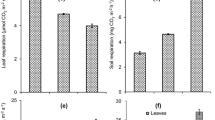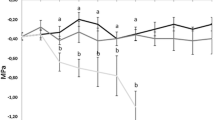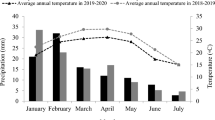Abstract
Tropospheric ozone (O3) is a major secondary air pollutant and greenhouse gas, and its impact on growth, yield, and its quality is well established in the case of crop plants. However, the effects of tropospheric O3 have not been comprehensively studied on medicinal plants. Therefore, a field study was planned on a medicinally important Sida cordifolia L. plant (commonly known as country mallow or Bala) to assess the expected changes on the morphology, growth, and leaf injury under elevated O3 (ambient + 20 ppb) by using open-top chambers (OTCs) at 30, 60, and 90 days after treatment (DAT), while leaf and root metabolites were observed at 60 DAT. At all the growth stages, significant leaf damage was recorded as foliar injury symptoms. Most of the growth parameters also showed significant reductions at all the growth stages. Plants under elevated O3 showed a significant negative impact on most of the reproductive parts of the plant. Leaf weight ratio (LWR) showed significant increment at early stages while reduced at 90 DAT; however, root shoot ratio (RSR) showed a significant reduction at 60 DAT. The majority of the steroid metabolites showed an increase in root and leaves under elevated O3, while terpenes showed variable response. Due to O3 stress, most of the major metabolites showed an increase possibly due to their role in defense and other metabolic activities. Based on the outcomes, it is concluded that the future increase in the levels of tropospheric O3 will impact a significant effect on important metabolites of medicinal plants growing in tropical countries like India.








Similar content being viewed by others
References
Abirami P, Rajendran A (2011) GC-MS determination of bioactive compounds of Indigofera aspalathoides. J Nat Prod Plant Resour 1(4):126–130
Bell JNB, & Ashmore MR (1986) Design and construction of open-top chambers and methods of filteration (equipment and cost). In: Proceeding of II European Open Top Chambers Workshop, September 1906, Freiberg, CEC, Brussels, pp. 46–56
Black VJ, Stewart CA, Roberts JA, Black CR (2012) Timing of exposure to ozone affects reproductive sensitivity and compensatory ability in Brassica campestris. Environ Exp Bot 75:225–234
Bosac C, Roberts JA, Black VJ, Black CR (1994) Impact of O3 and SO2 on reproductive development in oilseed rape (Brassica napus L.) II. Reproductive site losses. New Phytol 126(1):71–79
Cai Y, Jia JW, Crock J, Lin ZX, Chen XY, Croteau R (2002) A cDNA clone for β-caryophyllene synthase from Artemisia annua. Phytochemistry 61(5):523–529
Chaudhary N, Agrawal SB (2014) Cultivar specific variations in morphological and biochemical characteristics of mung bean due to foliar spray of ascorbic acid under elevated ozone. Acta Physiol Plant 36(7):1793–1803
Chaudhary N, Singh S, Agrawal SB, Agrawal M (2013) Assessment of six Indian cultivars of mung bean against ozone by using foliar injury index and changes in carbon assimilation, gas exchange, chlorophyll fluorescence and photosynthetic pigments. Environ Monit Assess 185(9):7793–7807
Dolker T, Agrawal M (2019) Negative impacts of elevated ozone on dominant species of semi-natural grassland vegetation in Indo-Gangetic plain. Ecotoxicol Environ Saf 182:109404
Emberson LD, Pleijel H, Ainsworth EA, Van den Berg M, Ren W, Osborne S et al (2018) Ozone effects on crops and consideration in crop models. Eur J Agron 100:19–34
Fatima A, Singh AA, Mukherjee A, Agrawal M, Agrawal SB (2018) Variability in defence mechanism operating in three wheat cultivars having different levels of sensitivity against elevated ozone. Environ Exp Bot 155:66–78
Fatima A, Singh AA, Mukherjee A, Agrawal M, Agrawal SB (2019) Ascorbic acid and thiols as potential biomarkers of ozone tolerance in tropical wheat cultivars. Ecotoxicol Environ Saf 171:701–708
Feng Z, Sun J, Wan W, Hu E, Calatayud V (2014) Evidence of widespread ozone-induced visible injury on plants in Beijing, China. Environ Pollut 193:296–301
Feng Z, Yuan X, Fares S, Loreto F, Li P, Hoshika Y, Paoletti E (2019) Isoprene is more affected by climate drivers than monoterpenes: a meta-analytic review on plant isoprenoid emissions. Plant, Cell & Environment
Ghosh A, Agrawal M, Agrawal SB (2020) Effect of water deficit stress on an Indian wheat cultivar (Triticum aestivum L. HD 2967) under ambient and elevated level of ozone. Science of The Total Environment 714:136837
Gil M, Pontin M, Berli F, Bottini R, Piccoli P (2012) Metabolism of terpenes in the response of grape (Vitis vinifera L.) leaf tissues to UV-B radiation. Phytochemistry 77:89–98
Gillespie KM, Rogers A, Ainsworth EA (2011) Growth at elevated ozone or elevated carbon dioxide concentration alters antioxidant capacity and response to acute oxidative stress in soybean (Glycine max). J Exp Bot 62(8):2667–2678
Grulke NE, Heath RL (2019) Ozone effects on plants in natural ecosystems. Plant Biol
Harmens H, Hayes F, Sharps K, Radbourne A, Mills G (2019) Can reduced irrigation mitigate ozone impacts on an ozone-sensitive African wheat variety? Plants 8(7):220
Hofius D, Hajirezaei MR, Geiger M, Tschiersch H, Melzer M, Sonnewald U (2004) RNAi-mediated tocopherol deficiency impairs photoassimilate export in transgenic potato plants. Plant Physiol 135(3):1256–1268
Huang M, Sanchez-Moreiras AM, Abel C, Sohrabi R, Lee S, Gershenzon J, Tholl D (2012) The major volatile organic compound emitted from Arabidopsis thaliana flowers, the sesquiterpene (E)-β-caryophyllene, is a defense against a bacterial pathogen. New Phytol 193(4):997–1008
Hunt R (1982) Plant growth curves. (Edward Arnold: London). Plant growth curves. Edward Arnold, London
Jain A, Shreya C, Singour PK, Rajak H, Pawar RS (2011) Sida cordifolia Linn-a review. J Appl Pharm Sci 1(02):23–23
Kangasjärvi J, Jaspers P, Kollist H (2005) Signalling and cell death in ozone-exposed plants. Plant Cell Environ 28(8):1021–1036
Kaur N, Chaudhary J, Jain A, Kishore L (2011) Stigmasterol: a comprehensive review. Int J Pharm Sci Res 2(9):2259
Kleanthous S, Vrekoussis M, Mihalopoulos N, Kalabokas P, Lelieveld J (2014) On the temporal and spatial variation of ozone in Cyprus. Sci Total Environ 476:677–687
Li P, Zhou H, Xu Y, Shang B, Feng Z (2019) The effects of elevated ozone on the accumulation and allocation of poplar biomass depend strongly on water and nitrogen availability. Sci Total Environ 665:929–936
Li Z, Yang J, Shang B, Xu Y, Couture JJ, Yuan X, Kobayashi K, Feng Z (2020) Water stress rather than N addition mitigates impacts of elevated O3 on foliar chemical profiles in poplar saplings. Sci Total Environ 707:135935
Lindroth RL (2010) Impacts of elevated atmospheric CO2 and O3 on forests: phytochemistry, trophic interactions, and ecosystem dynamics. J Chem Ecol 36(1):2–21
Liu X, Hua X, Guo J, Qi D, Wang L, Liu Z, Liu G (2008) Enhanced tolerance to drought stress in transgenic tobacco plants overexpressing VTE1 for increased tocopherol production from Arabidopsis thaliana. Biotechnol Lett 30(7):1275–1280
Magdy M, Mansour F, van Hasselt PR, Kuiper PJ (1994) Plasma membrane lipid alterations induced by NaCl in winter wheat roots. Physiol Plant 92(3):473–478
Mauzerall DL, Wang X (2001) Protecting agricultural crops from the effects of tropospheric ozone exposure: reconciling science and standard setting in the United States, Europe, and Asia. Annu Rev Energy Environ 26(1):237–268
Mishra AK, Rai R, Agrawal SB (2013) Differential response of dwarf and tall tropical wheat cultivars to elevated ozone with and without carbon dioxide enrichment: growth, yield and grain quality. Field Crop Res 145:21–32
Munné-Bosch S, Alegre L (2003) Drought-induced changes in the redox state of α-tocopherol, ascorbate, and the diterpene carnosic acid in chloroplasts of Labiatae species differing in carnosic acid contents. Plant Physiol 131(4):1816–1825
Munné-Bosch S, Schwarz K, Alegre L (1999) Enhanced formation of α-tocopherol and highly oxidized abietane diterpenes in water-stressed rosemary plants. Plant Physiol 121(3):1047–1052
Muthuraman MS, Sinsinwar S, Vetrivel U (2017) Anticancer activity of Sida cordifolia L.,–insilico approach. J Pharm Sci Res 9(8):1363
Pandey N, Pandey-Rai S (2014) Modulations of physiological responses and possible involvement of defense-related secondary metabolites in acclimation of Artemisia annua L. against short-term UV-B radiation. Planta 240(3):611–627
Persson K, Danielsson H, Sellden G, Pleijel H (2003) The effects of tropospheric ozone and elevated carbon dioxide on potato (Solanum tuberosum L. cv. Bintje) growth and yield. Sci Total Environ 310(1–3):191–201
Rao GU, Jain A, Shivanna KR (1992) Effects of high temperature stress on Brassica pollen: viability, germination and ability to set fruits and seeds. Ann Bot 69(3):193–198
Sallas L, Kainulainen P, Utriainen J, Holopainen T, Holopainen JK (2001) The influence of elevated O3 and CO2 concentrations on secondary metabolites of Scots pine (Pinus sylvestris L.) seedlings. Glob Chang Biol 7(3):303–311
Sarkar A, Agrawal SB (2010) Elevated ozone and two modern wheat cultivars: an assessment of dose dependent sensitivity with respect to growth, reproductive and yield parameters. Environ Exp Bot 69(3):328–337
Sarkar A, Agrawal SB (2012) Evaluating the response of two high yielding Indian rice cultivars against ambient and elevated levels of ozone by using open top chambers. J Environ Manag 95:S19–S24
Schauberger B, Rolinski S, Schaphoff S, Müller C (2019) Global historical soybean and wheat yield loss estimates from ozone pollution considering water and temperature as modifying effects. Agric For Meteorol 265:1–15
Shang B, Feng Z, Li P, Yuan X, Xu Y, Calatayud V (2017) Ozone exposure-and flux-based response relationships with photosynthesis, leaf morphology and biomass in two poplar clones. Sci Total Environ 603:185–195
Shang B, Feng Z, Li P, Calatayud V (2018) Elevated ozone affects C, N and P ecological stoichiometry and nutrient resorption of two poplar clones. Environ Pollut 234:136–144
Shang B, Yuan X, Li P, Xu Y, Feng Z (2019) Effects of elevated ozone and water deficit on poplar saplings: changes in carbon and nitrogen stocks and their allocation to different organs. For Ecol Manag 441:89–98
Sharma A, Sharma SK, Mandal TK (2016) Influence of ozone precursors and particulate matter on the variation of surface ozone at an urban site of Delhi, India. Sustainable Environment Research 26(2):76–83
Sicard P, Anav A, Marco AD, Paoletti E (2017) Projected global ground-level ozone impacts on vegetation under different emission and climate scenarios. Atmos Chem Phys 17(19):12177–12196
Silva RL, Melo GBD, Melo VAD, Antoniolli ÂR, Michellone PRT, Zucoloto S, Castro e Silva, O. D. (2006) Effect of the aqueous extract of Sida cordifolia on liver regeneration after partial hepatectomy. Acta Cir Bras 21:37–39
Singh AA, Fatima A, Mishra AK, Chaudhary N, Mukherjee A, Agrawal M, Agrawal SB (2018) Assessment of ozone toxicity among 14 Indian wheat cultivars under field conditions: growth and productivity. Environ Monit Assess 190(4):190
Smith WEC, Shivaji R, Williams WP, Luthe DS, Sandoya GV, Smith CL, Brown AE (2012) A maize line resistant to herbivory constitutively releases (E)-β-caryophyllene. J Econ Entomol 105(1):120–128
Sun J, Feng Z, Ort DR (2014) Impacts of rising tropospheric ozone on photosynthesis and metabolite levels on field grown soybean. Plant Sci 226:147–161
Sutradhar RK, Rahman AKMM, Ahmad M, Bachar SC, Saha A, Guha SK (2006) Analgesic and anti-inflammatory principle from Sida cordifolia Linn. Biological Sci 6:160–163
Swathy SS, Panicker S, Nithya RS, Anuja MM, Rejitha S, Indira M (2010) Antiperoxidative and antiinflammatory effect of Sida cordifolia Linn. on quinolinic acid induced neurotoxicity. Neurochem Res 35(9):1361–1367
Takshak S, Agrawal SB (2015) Alterations in metabolite profile and free radical scavenging activities of Withania somnifera leaf and root extracts under supplemental ultraviolet-B radiation. Acta Physiol Plant 37(12):260
Tarasick D, Galbally IE, Cooper OR, Schultz MG, Ancellet G, Leblanc T et al (2019) Tropospheric ozone assessment report: tropospheric ozone from 1877 to 2016, observed levels, trends and uncertainties. Elem Sci Anth 7(1)
Tiwari S, Agrawal M, Marshall FM (2010) Seasonal variations in adaptational strategies of Beta vulgaris L. plants in response to ambient air pollution: biomass allocation, yield and nutritional quality. Trop Ecol 51(2):353–363
Tripathi R, Agrawal SB (2012) Effects of ambient and elevated level of ozone on Brassica campestris L. with special reference to yield and oil quality parameters. Ecotoxicol Environ Saf 85:1–12
Valkama E, Koricheva J, Oksanen E (2007) Effects of elevated O3, alone and in combination with elevated CO2, on tree leaf chemistry and insect herbivore performance: a meta-analysis. Glob Chang Biol 13(1):184–201
Wang Y, Song Q, Frei M, Shao Z, Yang L (2014) Effects of elevated ozone, carbon dioxide, and the combination of both on the grain quality of Chinese hybrid rice. Environ Pollut 189:9–17
Wendakoon C, Calderon P, Gagnon D (2012) Evaluation of selected medicinal plants extracted in different ethanol concentrations for antibacterial activity against human pathogens. J Med Active Plants 1(2):60–68
Wittig VE, Ainsworth EA, Naidu SL, Karnosky DF, Long SP (2009) Quantifying the impact of current and future tropospheric ozone on tree biomass, growth, physiology and biochemistry: a quantitative meta-analysis. Glob Chang Biol 15(2):396–424
Yadav DS, Rai R, Mishra AK, Chaudhary N, Mukherjee A, Agrawal SB, Agrawal M (2019) ROS production and its detoxification in early and late sown cultivars of wheat under future O3 concentration. Sci Total Environ 659:200–210
Zouzoulas D, Koutroubas SD, Vassiliou G, Vardavakis E (2009) Effects of ozone fumigation on cotton (Gossypium hirsutum L.) morphology, anatomy, physiology, yield and qualitative characteristics of fibers. Environ Exp Bot 67(1):293–303
Acknowledgments
The authors are thankful to the Head, Department of Botany, Banaras Hindu University (BHU) for providing the necessary experimental and laboratory facilities. We are highly grateful to Dr. Jasmeet Singh, Department of Dravyaguna, Faculty of Ayurveda, Institute of Medical Science, Banaras Hindu University for providing seeds of Sida cordifolia and Advanced Instrumentation Research Facility, Jawaharlal Nehru University, New Delhi, for GC–MS analysis. We are also thankful to Dr. Arideep Mukherjee for his valuable support in various ways.
Funding
The Council of Scientific and Industrial Research (CSIR), Government of India, New Delhi, provided financial assistance in the form of a project.
Author information
Authors and Affiliations
Corresponding author
Ethics declarations
Conflict of interest
The authors declare that they have no conflict of interest.
Additional information
Responsible Editor: Gangrong Shi
Publisher’s note
Springer Nature remains neutral with regard to jurisdictional claims in published maps and institutional affiliations.
Electronic supplementary material
ESM 1
(DOC 30 kb)
Rights and permissions
About this article
Cite this article
Ansari, N., Agrawal, M. & Agrawal, S.B. An assessment of growth, floral morphology, and metabolites of a medicinal plant Sida cordifolia L. under the influence of elevated ozone. Environ Sci Pollut Res 28, 832–845 (2021). https://doi.org/10.1007/s11356-020-10340-y
Received:
Accepted:
Published:
Issue Date:
DOI: https://doi.org/10.1007/s11356-020-10340-y




